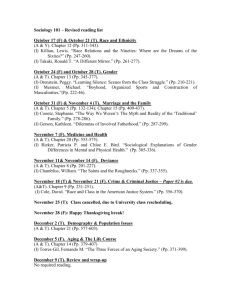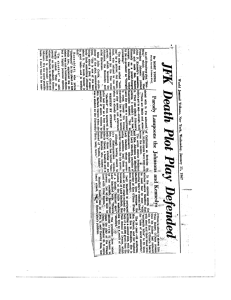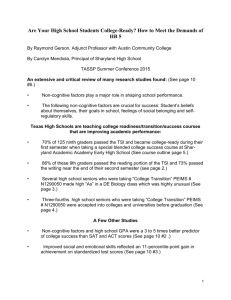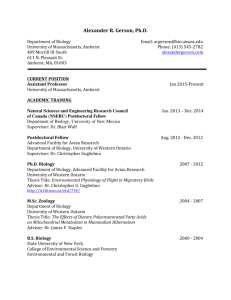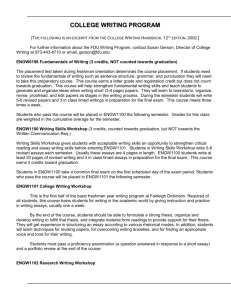gerson trust project to produce and use concentrated
advertisement
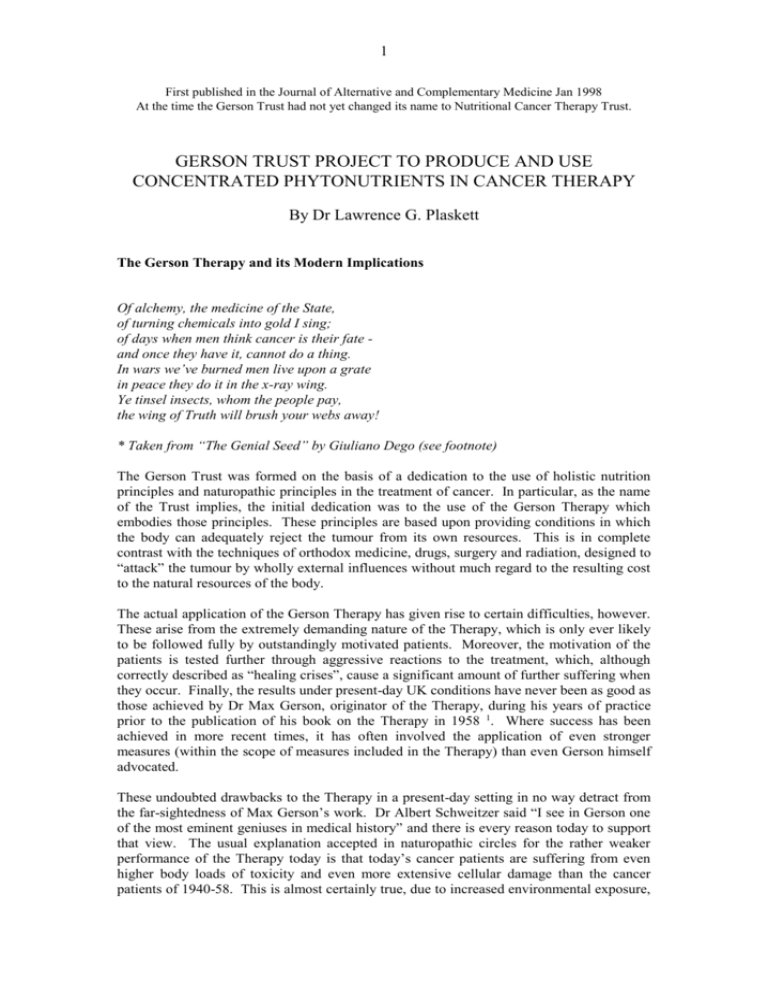
1 First published in the Journal of Alternative and Complementary Medicine Jan 1998 At the time the Gerson Trust had not yet changed its name to Nutritional Cancer Therapy Trust. GERSON TRUST PROJECT TO PRODUCE AND USE CONCENTRATED PHYTONUTRIENTS IN CANCER THERAPY By Dr Lawrence G. Plaskett The Gerson Therapy and its Modern Implications Of alchemy, the medicine of the State, of turning chemicals into gold I sing; of days when men think cancer is their fate and once they have it, cannot do a thing. In wars we’ve burned men live upon a grate in peace they do it in the x-ray wing. Ye tinsel insects, whom the people pay, the wing of Truth will brush your webs away! * Taken from “The Genial Seed” by Giuliano Dego (see footnote) The Gerson Trust was formed on the basis of a dedication to the use of holistic nutrition principles and naturopathic principles in the treatment of cancer. In particular, as the name of the Trust implies, the initial dedication was to the use of the Gerson Therapy which embodies those principles. These principles are based upon providing conditions in which the body can adequately reject the tumour from its own resources. This is in complete contrast with the techniques of orthodox medicine, drugs, surgery and radiation, designed to “attack” the tumour by wholly external influences without much regard to the resulting cost to the natural resources of the body. The actual application of the Gerson Therapy has given rise to certain difficulties, however. These arise from the extremely demanding nature of the Therapy, which is only ever likely to be followed fully by outstandingly motivated patients. Moreover, the motivation of the patients is tested further through aggressive reactions to the treatment, which, although correctly described as “healing crises”, cause a significant amount of further suffering when they occur. Finally, the results under present-day UK conditions have never been as good as those achieved by Dr Max Gerson, originator of the Therapy, during his years of practice prior to the publication of his book on the Therapy in 1958 1. Where success has been achieved in more recent times, it has often involved the application of even stronger measures (within the scope of measures included in the Therapy) than even Gerson himself advocated. These undoubted drawbacks to the Therapy in a present-day setting in no way detract from the far-sightedness of Max Gerson’s work. Dr Albert Schweitzer said “I see in Gerson one of the most eminent geniuses in medical history” and there is every reason today to support that view. The usual explanation accepted in naturopathic circles for the rather weaker performance of the Therapy today is that today’s cancer patients are suffering from even higher body loads of toxicity and even more extensive cellular damage than the cancer patients of 1940-58. This is almost certainly true, due to increased environmental exposure, 2 though it is also likely that Gerson’s own clinical skills were at least partly responsible. It was, of course, his therapy, and he would have tailored the application closely to the patient. Any modern re-assessment of the medical philosophy and treatment strategy so ably set out by Gerson has to take into account this progressive weakening of the effectiveness of the Therapy with the passage of the years, which has led to even more stringent treatment conditions and even more powerful adverse reactions to therapy. An almost religious selfsacrificing zeal is therefore now needed to obtain even the possibility of results with the Gerson method. However, that re-assessment must also, to be realistic, take fully into account that Gerson himself did cure 50 cancer patients without aid from orthodox means and that the members of Gerson’s family who have sought to continue his work since his death in 1959 have also had remarkable levels of success, albeit in the face of increasing difficulty. This has resulted in significant numbers of Gerson Therapy patients alive today who can tell their own story. Two of them have written books about their experience. These are an American lady, Jackie Davidson in her book “Cancer Winner” 2 and a British lady, Beata Bishop in her book “A Time to Heal” 3. An Italian gentleman, Giuliano Dego survived his cancer via the Gerson Therapy and recorded his appreciation of Dr Gerson’s approach by writing a poem “The Genial Seed” 4. Through the medium of poetry he was able to be somehow even more effectively scathing than is possible in prose about what he saw as the negativity of orthodox cancer treatment. The publisher’s introductory background relating to this poem follows at the end of this article. These events do not constitute a proof of the Gerson Therapy in strict scientific terms. Nonetheless, to voluntarily ignore such results one has to be either very “dyed in the wool” in one’s medical outlook or, perhaps, be among those who feel their vested interests are being threatened by the treatment methods involved. Any open-minded evaluation of this situation is almost bound to conclude that the principles adopted by Max Gerson are calling out for thorough investigation in a modern setting. Moreover, the research funds needed for such an evaluation are quite minuscule compared to the giant resources nowadays being ploughed into orthodox cancer research. Government is unlikely to support this work because Government seeks its advice only from the medical orthodoxy. However, there are the strongest possible reasons for charities that collect money for cancer research to consider redirecting at least a proportion of their funds, perhaps appealing to the public specifically on the grounds of a wish to explore the alternative approach. The Biochemical Approach Max Gerson was an intrepid explorer of the science of medicine. There can be no doubt that, had he lived and actively worked for longer, he would have modified his Therapy to take account of newly emerging nutritional and biochemical knowledge. Since his death, although his Therapy has been applied by his family with great dedication, there has been no scientist of imagination and creativity dedicated to the extension and development of Gerson’s ideas. The fact is that in almost 40 years since Gerson published his book the whole environment within which the Gerson Therapy exists has altered beyond recognition. Modern nutrition and biochemistry have made discoveries that are entirely compatible with Gerson’s basic ideas and which are capable of supporting them thoroughly. Few people, if any, have been pointing this out, presumably because of the suppression of fresh ideas as already discussed above. By the same changes, a few of Gerson’s individual treatment measures composing his Therapy, have become questionable, and stand in need of revision. 3 Stimulation of liver function through coffee enemas and other means are basic to the Gerson Therapy. Today we have so much more knowledge of the toxins that afflict the population and of the detoxifying enzyme systems of the liver and other organs, that it would be perfectly feasible to monitor scientifically the levels of these enzymes and the rates of detoxification, showing to what extent effective stimulation and detoxification were being achieved through any given pattern of treatment. The naturopathic view of coffee enemas is that they increase the flow of toxin expulsion through the liver in bile, helping to detoxify the body, at the same time helping to relieve the crises. There is every clinical reason to accept that view, though it is not scientific. Now however, scientifically, coffee enemas are known to induce raised levels of the detoxifying liver enzymes, the glutathione Stransferases. Some of those who have questioned their efficacy may be convinced by this biochemical evidence 5. Secondly, at the end of his life Gerson somehow perceived that high quality linseed oil was an important therapeutic item. He did this at a time when the scientific reasons for doing so were not clear apart from its ability to reduce the level of blood cholesterol. Linseed oil is a concentrate of alpha linolenic acid, a member of the group known as “Omega 3”, a subgroup of the essential fatty acids now known often to be nutritionally scarce and yet essential to a wide range of very far-reaching cellular functions. Most vegetable oils contain overwhelming quantities of Omega 6 fatty acids, producing an imbalance. The long term consequences of Omega 3 deficiency are severely disruptive at cellular and tissue level 6 - 8. Gerson’s use of substantial amounts of supplementary potassium has also been fully vindicated by the discovery of the essential role of intracellular levels potassium in maintaining cellular health 9. Gerson also recognised that the digestive system of the cancer patient was usually underfunctioning, with the result that nutrients are being only partially extracted from the food. To counter this he gave digestive enzymes. Gerson’s observations of this and his reasoning still appear sound 10,11. Another major plank of Gerson’s strategy was a diet mainly of organic fruits and vegetables and a regime of about a dozen fruit and vegetable juices each day. Gerson obviously had the clearest possible understanding that fruits and vegetables were therapeutic. He did not know precisely why and at that time the science required to find out was simply not available. He explained the effects in terms of “live enzymes”, but this reasoning is probably not correct, or, if it is, not significant. This general idea, although unpalatable to orthodox physicians, was in accord with the naturopaths of Gerson’s day and since. By contrast the need for Gerson’s use of castor oil, iodine and iodide, dried thyroid, liver juices and liver injections has tended to become increasingly questionable. There is little or no evidence of benefit from iodine at levels which exceed normal adequacy. High intakes of both iodide and thyroid hormone have the ability to actually suppress thyroid function. It seems likely that if Gerson was able to positively pinpoint benefits from intake of liver that it was most likely to be through the liver’s storage function for nutrients, which makes liver an especially nutrient-dense food. However, the high protein content of liver is more than likely to be counter productive in naturopathic therapy, while the liver is known often to be the most toxic part of an animal (a situation that has got worse since Gerson’s time). Today, these concentrated nutrients can be best provided by supplements, thereby giving better control of measured intakes and avoiding all the disadvantages connected with liver itself. Indeed, a major aspect of Gerson’s approach was to provide a situation of nutrient luxury for all the body cells. This was to enable to liver and other organs of elimination to cleanse 4 themselves and to enable the immune system to revitalize itself to attack the tumour by natural means. In other words, the body system which should have provided the protection against cancer in the first place was being put back into order. Today, the availability of high quality nutritional supplements is such that a substantial part of the therapy can clearly be performed through their use. If that is so, then some, at least, of the measures used by Gerson to provide nutrient luxury can be relaxed, making the therapy rather more userfriendly. The writer has long been an advocate of forms of nutritional therapy which, while being entirely naturopathic in concept, made the fullest use of modern supplements. In answer to the question “can’t we get all this from foods”, the answer is a resounding “no” because foods, particularly today’s foods in the quantities we can eat, simply do not deliver many of the nutrients at the levels required for substantial therapeutic effect. The scientific and medical literature is nowadays full of references to work in which the responses of cancer to individual nutrients (vitamins and minerals) have been carefully measured. This covers use of nutrients in prevention - giving the nutrients to whole groups of people and seeing how their expected incidence of cancer changed as a result. It also covers recurrence situations, in which people who have been successfully operated for cancer have been given the nutrients to find out how the recurrence rates were affected. Results obtained in both these situations have been very positive indeed. The role of nutrients in cancer prevention also in minimizing cancer recurrence must be considered fully established. These connections between cancer and individual nutrients have been well documented popularly by Jean Carper in books like “Food Your Miracle Medicine” 12 and “Stop Ageing Now” 13 and more scientifically by Simone in “Cancer and Nutrition” 14. Although these are not the situations with which we are primarily concerned here, the orthodoxy should nonetheless be put “on the spot” to answer why it is that they and the Government have done nothing to promote these obvious preventative methods and why it is that cancer patients who have been operated upon surgically with apparent success (but with known risks of recurrence) are discharged without any nutritional advice. Most of the above work has been done with just single nutrients to avoid complicating the trials. However, the strategy of nutritional medicine has to be to bring together combinations of effective nutrients. One might well expect, therefore, that combined therapy with multiple relevant nutrients would be much more effective than the often impressive single nutrient trials. The same three books mentioned in the above paragraph also document most strongly the effectiveness of fruits and vegetables in diets for the initial prevention and / or recurrence prevention of cancer. Today there is really no controversy, even with orthodox science, about the effectiveness of high intakes of fruits and vegetables for both of these purposes, though still precious little has been done about it by the medical profession 15. To that extent, Gerson’s policy of concentrating upon fruits and vegetables in therapy is being underwritten by today’s medical science. However, most medical scientists would object that the requirements for therapy are unlikely to be the same as the requirements for prevention or recurrence. In other words, avoiding letting the cat out of the bag calls for different precautions from the measures required to recapture the cat after it has escaped. In principle, it at first seems hard to argue with that idea. The actual presence in the body of thoroughly altered cells - cancer cells - might well call for quite different measures from those needed to stop the cancer from coming about in the first place. We now consider to what extent that is true. 5 Can Nutrients Fight Active Cancer? Although the writer has been giving nutritional supplements to cancer patients for almost two decades, clinical trials have taken place only quite recently. Following some work which showed that administration of high doses of Co-Enzyme Q10 16 could favourably influence the progression of established cancer of the breast, Lockwood and colleagues 17 set out to find out the effect of combining this co-enzyme with a wide range of other vitamins and minerals. The trial involved 32 women with breast cancer. In a period running from 1992 to 1995 none of the women died of the disease, none of the women showed signs of the development of distant metastases, whilst six showed some degree of remission, extending in two cases to actual disappearance of the tumour. Further results from continuation of this study are awaited, but at this stage it appears from the above work that nutritional supplements alone, whilst not a complete therapy in themselves, have a markedly favourable influence even upon actively growing tumours. Based upon this writer’s own past experience, and backed up by the above work, the Gerson Trust’s current treatment strategy involves giving a wide range of such supplements. It should be noted that the range of minerals being employed includes two - potassium and chromium - not included by the Lockwood investigators. Lockwood’s highly favourable results, obtained without the use of potassium or potassium sources, and surely must have been much disadvantaged by this omission. Can Fruits and Vegetables Fight Cancer? There seems little doubt that if one has active cancer, then just eating parsnips, carrots, or any other vegetable, will make relatively little difference. To most people “eating a lot of carrots” may mean eating two or three per day. All the indications are that if one wants vegetables to make any difference, one’s ordinary ideas about what constitutes “a lot” have to be revised severalfold. One then encounters the problem that one not only gets fed up with eating them but one may be physically unable to eat them. The intensive programme of juicing introduced by Gerson, using the juice as a fibre-free vegetable concentrate, must be eminently sensible if it is true that vegetables can fight active cancer. We have no science to show whether they can or not, even though the science that supports their use for prevention is so very strong. In order to begin to answer the question we have to look at the nutrient composition of vegetables and fruit. They contain large amounts of minerals and vitamins. All these contribute to the “nutrient luxury” which Gerson was trying to create. That was important for the Gerson Therapy, but are they still important today for the same reason? Not necessarily so if supplements of these same minerals and vitamins are being provided. Is there any chance of the fruit and vegetable component of the therapy being made redundant? The answer appears to be no chance at all, at least, not without much expanded knowledge and even better supplement technology. What nowadays do we consider to be the substances in fruits and vegetables most likely to have a therapeutic effect? This is just what Gerson was in no position to find out. Today we have quite good knowledge of this even though it is bound to be incomplete. Fruits and vegetables may exert some therapeutic effect by providing the minerals and vitamins that are well known. However, their uniqueness in the field of prevention would appear to be largely mediated through less known substances, not just conventional vitamins, which are referred to under the blanket name of “phytonutrients”. This name correctly communicates that they are rather unique to plants. A lot of them fall into major groups called “carotenoids”, “flavonoids”, “indoles” and thiocyanates. Others are ellagic acid, coumarins, 6 limonoids. This list is by no means exhaustive. Some of these have been reviewed by Passwater 18. There are some 4,000 flavonoids known to science for starters, though not all of them occur in foods. It is known that we tend to consume from 100mg to 1000mg of these per day. It may be extremely important as to whether it is the lower or the higher of these figures, but it is also very important which flavonoids we choose - a thought which can make us all feel very ignorant about our choices of diet. It is not known which ones out of this huge hoard of phytonutrients, contribute most to the cancer preventative effects of fruits and vegetables. Even less is it clear which ones are candidates for the role of non-toxic chemotherapeutic agents against cancer. The attempt to find out by measuring the amounts of them in people’s diets is frustrated by their number and complexity. People in the population who eat more of one type may eat less of another, making it impossible to line up cause and effect through the study, either of cancer patients’ diets or of “prospective” studies which look at a population’s spread of dietary habits and follow up their connections with cancer incidence as the years go by. There have been only very limited studies so far on the actual treatment of cancer with phytonutrients. However, studies in the laboratory show that many of these compounds possess the ability to specifically inhibit the growth of tumour cells in tissue culture 19 - 20. This sort of evidence is the most direct evidence we have from science that Gerson was most probably right all the time in stressing the role of fruits and vegetables in his treatment. He must have experienced no end of frustration from not knowing with what biochemicals he was dealing and being unable to take steps to maximise their concentrations in his therapeutic diet. He was forced to take a kind of “pot luck” with that aspect of the treatment. Today we know that if, for example, we want to maximize a particular flavonoid called “quercitin” in the diet, then we ought to eat a lot of onions. Quercitin does possess some deeply interesting properties, though it is just one of many candidate compounds. A diet of onions would soon become pretty disagreeable to most of us because of their great pungency. Onion juice, on its own, would be even more disagreeable. However, a concentrate of onions might well deliver to us the quercitin extracted from a kilo of onions in an ounce of fluid. If this had a disagreeable taste, we could put up with that. However, the technologists might well be able to remove most of the pungency of the onions anyway, so that no acceptability problem would then occur. It is possible to buy quercitin as a nutritional supplement. The reason why this writer does not necessarily advocate doing so, at least as a major plank of treatment, is because of the real doubt which still exists as to whether or not quercitin, which is only one from amongst a very wide range of candidate substances, is exactly what is needed to help the body rid itself of any particular form of cancer. This subject must be considered very much in its infancy. We know of a good many phytonutrients which have been shown to have anticancer powers. This power may be properly called “anti-neoplastic activity”, meaning antitumour activity, as distinct from “anti-carcinogenic activity”, which refers to the prevention of the initial cancerous transformation. The Strategy of the Gerson Trust Project and Therapy This strategy consists of putting together those components of nutritional therapy for cancer which look most positive, based upon the evidence that is available at the present time. This includes; Coffee enemas (but less than Gerson used) Fruit and vegetable juices (but less than Gerson used) 7 Potassium (much the same as Gerson) but with magnesium in addition, due to its direct requirement for the sodium pump at the cell membrane 21. Linseed oil (as Gerson) or fish oil Digestive Enzymes (much the same as Gerson), but now supplemented with free-form amino acids, not used by Gerson Bowel flora bacteria (strains known for their anti-tumour influence, not used by Gerson) Aloe vera (for its known immune system stimulation, not used by Gerson) A diet high in fruits and vegetables (as Gerson) but concentrating on those particular fruits and vegetables known to maximise those phytonutrients shown in laboratory work to have anti-neoplastic activity. Where appropriate, adjustment of the therapy to suit differences between the known biochemistry of cancers of particular types or sites. The use of high concentrates of fruits and vegetables carefully selected for their content of the best indicated anti-neoplastic phytonutrients - the object being to administer more of the effective substances than Gerson could ever do whilst at the same time making the therapy more user-friendly. This requires the development of techniques to produce such concentrates in a form most likely to embody the desired potency. A wide spread of trace elements and vitamins, mostly at intakes above the usual estimated daily requirements The Project to Deliver the High-Concentrate Component of the Therapy This part of the programme is now going through its desk-research stage. The literature is being carefully screened to provide information on the phytonutrients with the most antineoplastic activity and their best sources. This will lead to the definition of laboratory techniques to concentrate these phytonutrients. The object will be not be to isolate individual pure phytonutrients, but rather to provide concentrates known to have a definite content of particular phytonutrients along with a spread of other closely related phytonutrients. This strategy of deliberately including a range of related substances (which can nonetheless be largely defined by analysis of the material) will result in spreading the net as widely as possible to capture many of those flavonoids, carotenoids etc. not specifically targeted, which nonetheless may be capable of contributing to the therapeutic result. It is this work which is really new and different from all the previous work. Special funding is needed for the laboratory and pilot plant stage of this work and to enable the Trust to establish a production centre for these concentrates so that they can be used in regular treatments. The Trust is encouraged in this endeavour by some early experiences in which fruit and vegetable extracts of this type have been found to produce actual tumour regression in human subjects. * “This unique verse tribute is in recognition of the centenary of Dr. Max Gerson, born on October 18th. 1881 in Wongrowitz, province of Posen, Germany. In Europe, Dr. Gerson was a specialist in internal medicine and nervous diseases. After World War I he came to international attention for his work in treating tubercular disease by means of diet therapy. The Internationally renowned physician and surgeon Dr. Ferdinand Sauerbruch wrote in his book, MASTER SURGEON, about the results of his experiment in Munich with 450 patients with the until then considered incurable lupus or tuberculosis of the skin. By means of the Gerson Diet therapy 446 of the patients completely recovered. In the United States, Dr. Gerson interested himself In the study and treatment of cancer. His therapy attracted such attention that he and five of his patients were invited before a Sub-Committee of the United States Senate holding hearings on means of curing and preventing cancer. However, 8 his approach to the treatment of cancer, eschewing drugs, surgery and radiation, threatened the very core of the American medical establishment. Thus, opposition from the medical authorities prevented his findings from reaching the public and funds were never made available for his research. Despite this, he continued to practice with striking success in New York City. He died there on March 8th, 1959. The dissemination of his writings and ideas is being continued by the Gerson Institute and at the Gerson clinic by a group of doctors disenchanted with conventional medical practice.” References 1. Gerson, M. "A Cancer Therapy - Results of 50 Cases", , Totality Books, Del Mar, CA, U.S.A. (1977). 2. Davidson, Jackie, “Cancer Winner”, Pacific Press, Pierce City, Missouri, USA (1977). 3. Bishop, Beata, “A Time to Heal”, , Hodder & Stoughton, (1985), reprint, Penguin Arcana Range (1996). 4. Dego, G., "The Genial Seed”, Totality Books, Bonita, CA, USA (1981). 5. Hildenbrand G., “How the Gerson Therapy Heals” Transcript of a Lecture. Healing Newsletter, The Gerson Institute, (December 1990). 6. Erasmus, U. “Fats that Heal Fats that Kill”, , Alive Books, Burnaby, BC Canada (1986, 1993), especially p44. 7. Lands, W, “Fish and Human Health”, Academic Press Inc. (1986). 8. Bourre, J-M, “Brainfood”, (1990, translation 1993), Little, Brown & Co., pp50-69, especially p56-57. 9. Moore, R.D., “High Blood Pressure Solution - Natural Prevention and Cure with the K Factor”, Healing Arts Press, Rochester, Vermont, U.S.A. (1993), especially pp 56-118. 10. Bland, J., “Effect of Orally Consumed Aloe Vera Juice on Gastro-Intestinal Function in Normal Humans”, Preventive Medicine, March/April (1985). 11. Erdmann, R., “The Amino Revolution”, Simon & Schuster Inc. NY, USA (1989), especially Chapter 15, pp 130-133. 12. Carper, Jean, “Food Your Miracle Medicine”, (1993), Simon & Schuster, London. 13. Carper, Jean, “Stop Ageing Now - The Ultimate Plan for Staying Young and Reversing the Ageing Process”, Thorsons (1996). 14. Simone, C. B., “Cancer & Nutrition”, Avery Publ. Group Inc. (1992) 15. Griffiths, K., Adlercreutz, H., Boyle, P., Denis, L., Nicholson, R.I. & Morton, M.S., “Nutrition and Cancer”, Isis Medical Media Ltd., Oxford (1996), Chapter 3, pp 15-23. 16. Lockwood, K., Moesgaard, S., & Folkers, K., “Partial and Complete Remission of Breast Cancer in Patients in Relation to Doses of Co-enzyme Q10”, Biochem. Biophys. Res. Comm. 199 1504-8, (1994). 9 17. Lockwood, K., Moesgaard, S., Hanioka, T. & Folkers, K., “Apparent Partial Remission of Breast Cancer Patients Supplemented with Nutritional Anti-Oxidants, Essential Fatty Acids and Co-Enzyme Q10”, Mol. Aspects Medicine, 15 Supp, s231 - s240, (1994). 18. Passwater, R.A. “Cancer Prevention and Nutritional Therapies” Keats Publishing Inc. New Canaan, Connecticut, USA (1978), especially Chapter 15, pp 89 - 93. 19. Passwater, R.A. “Cancer Prevention and Nutritional Therapies” Keats Publishing Inc. New Canaan, Connecticut, USA (1978), especially Chapter 15, p 91. 20. Kandaswami C., Perkins E., Soloniuk D.S., Drzewiecki G., Middleton E Jr., “Ascorbic Acid-Enhanced Antiproliferative Effect Of Flavonoids On Squamous Cell Carcinoma In-Vitro” Anti-Cancer Drugs 4 (1) 91-96 (1993). 21. Hughes, M.N., “Storage, Transport and Function of Non-Transition Elements” Inorganic Biochemistry, pp 88 - 119, The Chemical Society, London 1979. About the Author L.G. Plaskett qualified at Clare College, Cambridge and has a doctorate from UCH Medical School of London University. He is Principal of the Plaskett Nutritional Medicine College which trains practitioners in a University Accredited Course; is a visiting lecturer in Complementary Health Studies at the University of Exeter and consultant to several companies in the nutrition field, as well as to the Gerson Trust.
